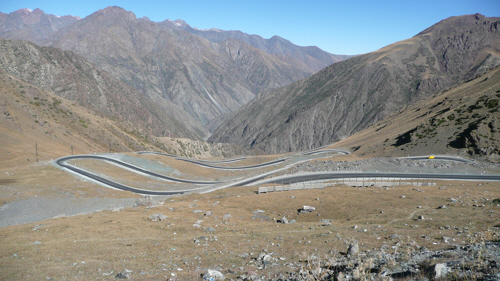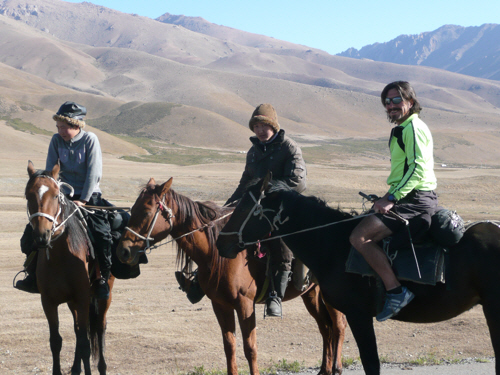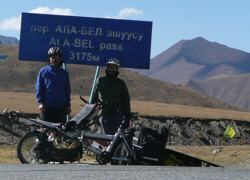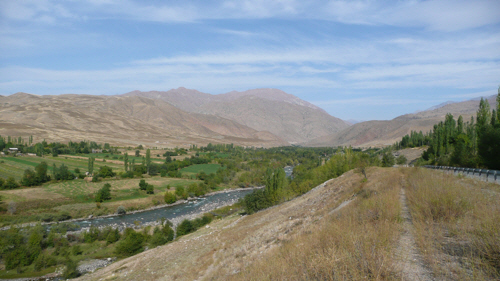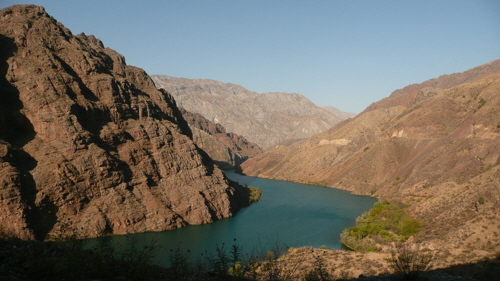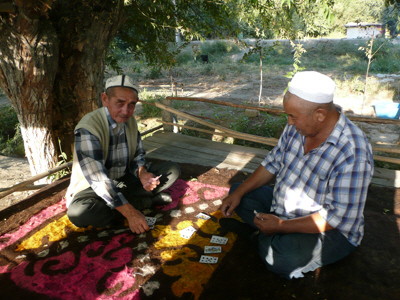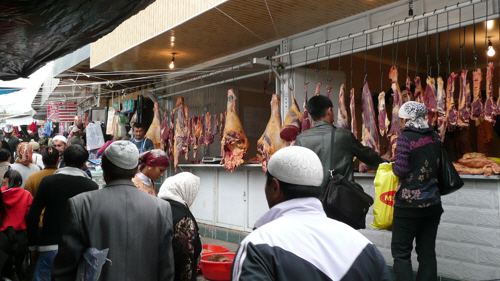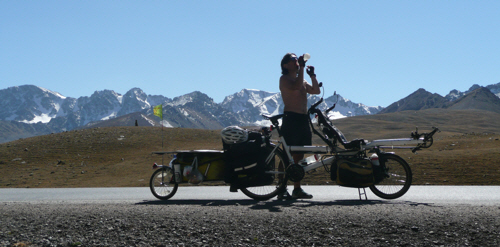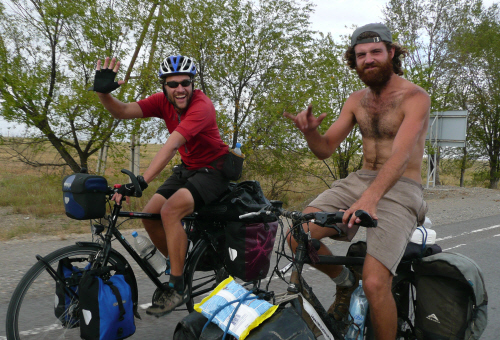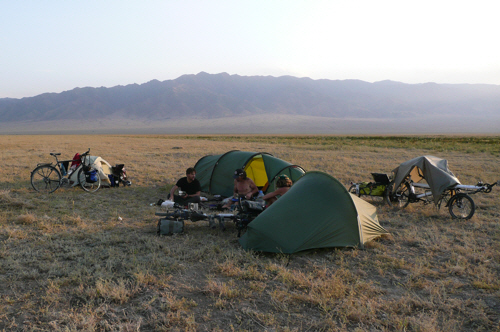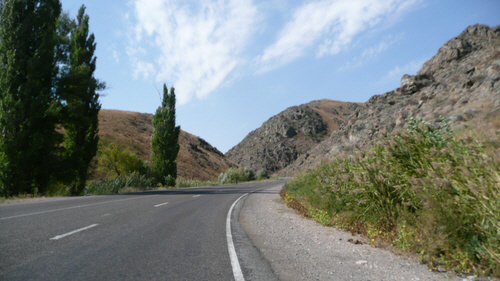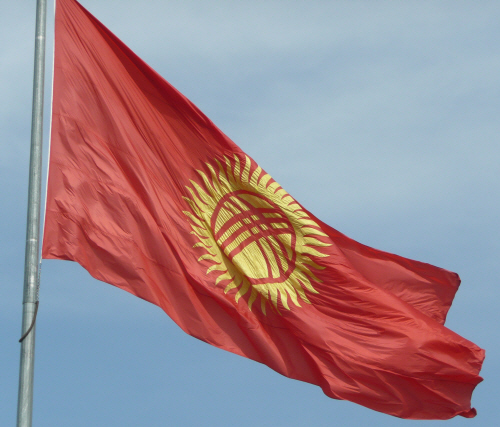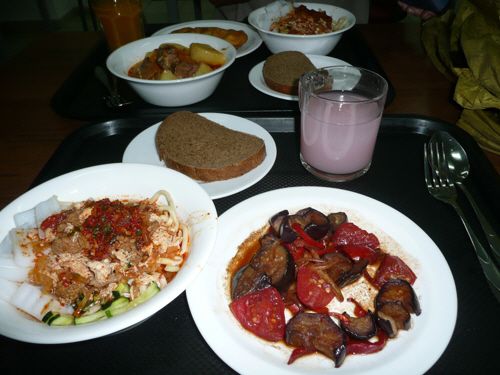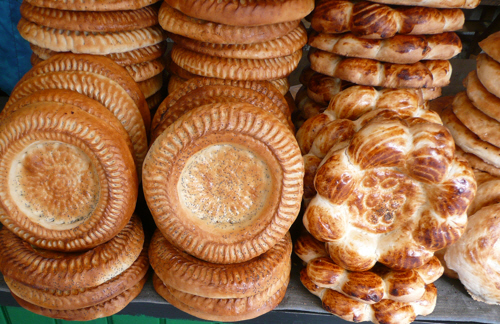We’ve laboured up mountain passes, camped in sub-zero temperatures on high plateaus, swapped saddles with herdsmen, tasted (with varying degrees of enjoyment) the local delicacies, whizzed gleefully down beautifully asphalted descents, pedalled through dry and desolate ‘moonscapes’, seen a baby donkey frolicking, camped in the garden of a retired truck-driver-cum-teahouse-owner, discovered what cotton plants look like, repeatedly failed to make ourselves understood when asking for a tin of tuna in the bazaars and been victim to the caprices of the God of Small Pointy Things, awaking as we did one morning to three deflated tyres.
Right, that’s the short version for the time-constrained amongst you. For those who are gluttons for punishment, here’s the long one:
We left Bishkek on a bit of a sour note after an argument with the support agency that had helped us obtain our Chinese visas. You may recall from our last post that the Chinese embassy only opens for visa business on a Wednesday and Friday morning and it usually takes five working days to process an application. So after our agency told us we’d missed the Friday morning deadline we’d agreed to pay an extra $40 for a fast-track service so that when our applications were submitted the following Wednesday we’d get the visas on the Friday instead of having to wait until the Wednesday after. At first all seemed to have gone well. We picked up our visas on the Friday and all appeared to be in order…and then Keith noticed that the issue date was actually several days earlier. In fact they were issued on the Tuesday, a day before they’d allegedly been submitted. We asked the agency lady what had happened; had there been a miscommunication between us and her, or between her and the embassy? Had the application been accepted the previous Friday after all? And why had no-one contacted us (she had our email address) to let us know the visas were ready early? We’d been kicking our heels at the guesthouse waiting for the visas. Sadly, the agency lady was not forthcoming with answers and tried various evasive and contradictory responses ranging from “You did not come here last Friday” (quickly countered by our production of a dated receipt) to “You should use your brains and should have realised that a fast-track service would mean they’d be ready on Wednesday”. It all got a bit unpleasant and in the end we managed to get $20 back to cover the extra two nights we’d spent at the guesthouse. It wasn’t a nice way to be leaving Bishkek, but at least we’d got our Chinese visas, unlike the French couple we’d met who were using the same agency and who had ended up with a visa for the husband but not for the wife. The last we saw of them they were heading directly to the Chinese embassy to see if they could get some kind of explanation as the agency lady had not been able to help them. For reference it was the Bai Ma agency that we used. Other travellers have reported favourably on their service but we wouldn’t necessarily recommend them.
Anyhow, we were back on the road and quick to put the sourness behind us. Mountain passes were looming large, and there’s nothing like a day and a half of climbing to help you work through any feelings of annoyance.
After an afternoon rolling west along the flat road out of Bishkek, we camped close to the town of Kara Balta, where a turn to the left takes you south and the road starts to head skywards.
Most of Kyrgyzstan is mountainous. In the winter the country is effectively split into two as road links between Bishkek in the north and the other major cities in the south, are completely blocked by snow for months on end. Bishkek sits at around 800m above sea level and to reach Osh we would be crossing two passes of over 3000m and numerous smaller ones. This was unchartered territory for us; the only comparable climbs we’ve done in the past have been in the Alps and Pyrenees on road bikes unfettered by luggage. Climbing on a loaded Pino whilst towing a trailer is entirely different.
Our first 30km of climbing was gentle enough, the rise only noticeable in our slow pace as we headed across seemingly flat terrain towards the sharp line of mountains. From the town of Sosnovka we entered the mountains properly and followed a winding road through dramatic rock faces following the path of the Kara Balta river. The gradient was not too demanding and for a further 30km we toiled sedately upwards, generally keeping a pace of around 8-10km per hour.
Fifteen kilometres from the tunnel that marks the top of the climb things took a decided turn towards the vertical. We left the gently tumbling Kara Balta river and the road began to twist more aggressively in a series of switchbacks. We were straining to maintain 6kph and stopped frequently to ‘admire the view’ or, in reality, wait for our wracked and rapid breathing to return to the realms of normality.
By the time the sun dipped behind the dark peaks we’d made it to 2500m, with a further 10km and 600+m of climbing remaining. Realising we’d never make it to the top that evening we scrubbed our plans of camping on the plateau on the other side of the tunnel and instead hunkered down behind a concrete barrier right next to the road on the only remotely horizontal piece of ground we could see. Temperatures dropped to 3C in the tent overnight and even with my new down booties on inside my sleeping bag my toes were painfully cold.

Not the quietest night’s sleep, with lorries chugging past just the other side of the concrete barrier.
The next morning we continued our upwards journey and after two hours of sweating and swearing (particularly at the drivers who think it’s fun to lean on the horn as they come up behind you and you can’t tell if it’s meant as encouragement or abuse) we finally made it to the tunnel at about 3150m, giving the climb a total ascent of 2350m.
Fifteen minutes of ear-splitting, thunderous, fume-choked darkness later and we exited the tunnel whereupon our labours were rewarded by the jaw-dropping view of the Suusamyr plateau. Snow-capped peaks surround a flat, grassy plain dotted with yurts, horses, cattle, sheep and goats. The road swoops down on pristine tarmac and both the scenery and the rush of cold air take your breath away. Keith doesn’t like favouritism and refuses to be drawn on the topic, but I have to admit that the Suusamyr plateau is one of the highlights of the trip so far for me.
Despite the rumbling lorries belching their way up and down the climbs, the air up on the plateau was crisp and fresh in our nostrils, softened occasionally by the sweet musk scent of horses. The above photo is misleading as the mountains appear hidden by haze, whereas in reality the air was crystal clear, unlike the air in the valleys on either side where the fumes from badly maintained engines and other pollutants leave a bitter-tasting smog in the air. Above us was cloudless blue sky, to the right yellow-brown grass slopes, to the left dramatic snow-tipped jags of rock. The plain extended around us, golden with a brief flash of green where Suusamyr river runs through it.
We’d descended to about 2100m and then began a long, slow ride up the plateau into a headwind, towards a highpoint of the next pass at 3184m. After the morning’s exertion to reach the tunnel we treated ourselves to a leisurely lunch of hot pasta salad with tomatoes, peppers, cucumber, onion and kolbasa sausage, followed by post-prandial snooze in the hot sun. One of the curious things about high places is the way that they can feel hot and cold at the same time. The sun can be roasting your cheek whilst the wind is sliding icy fingers down your collar, and the air is cold and dry in your nostrils. Is there a word for this hot-coldness? If not, there should be. It’s a delicious contrast.
Once more, we made it to around 2500m before calling it a day and setting up our tent on the wide open expanse of grassland. As the sun disappeared the temperature fell quickly, and far enough to put ice in our water bottles overnight. A new strategy of wearing all my clothes and keeping my socks on inside my down booties ensured a toasty night’s sleep though.
A short while before we went to bed we heard a whistling outside our tent. We unzipped to find an amiable looking man who squatted down and shook our hands in turn, and then continued to squat, staring into the tent and making no attempt whatsoever to speak to us. We said ‘hello’ in our best Russian but didn’t get much of a reply, and on further questioning it turned out he didn’t speak any Russian, only Kyrgyz (which we don’t speak at all). This was a novel situation for us and the first time in Central Asia that we’d come across someone over the age of ten (aside from other tourists) who couldn’t speak Russian. We waited to see what he wanted but he just kept staring at us in a comfortable manner that suggested he’d happily sit there all night. A freezing wind was howling in through the door and Keith and I both wore strained smiles as we tried to work out what to do next. We were half-tempted to invite him in to share some biscuits, but as he was making no attempt whatsoever to communicate and seemed happy to just squat and stare at us we felt quite perplexed by his behaviour and were worried that if we invited him in we wouldn’t be able to get rid of him. To our shame we decided to mime that we wanted to go to bed, at which point he promptly waved goodbye and left us. The next day we felt really bad. We should have invited him in even though we had no common language….and especially as people have been so hospitable to us.
Other people’s kindness towards us was amply demonstrated the next day when a herdsman rode up alongside us and chatted for a while. He then caught up with his comrade and a small group of horses, cattle and sheep, and then they both came cantering over to us. The second herdsman offered me his horse and so we swapped saddles: I herded and he rode the Pino. Later on another group of herdsmen stopped and did the same for Keith.
The herdsmen also gave us an old fanta bottle full of kymyz – fermented mare’s milk. Kymyz is a Kyrgyz speciality, sold by the bucketful by street vendors and at bazaars in the towns and cities, and in pretty much every roadside yurt up on in the mountains. Unfortunately we haven’t really developed a taste for this slightly fizzy, sour concoction, but after drinking a few obligatory mouthfuls with our new friends we did find a good use for the remainder. The part-drunk bottle was carried prominently for several days and proved to be a useful way to turn down further offers of kymyz without (hopefully) causing offence. “Oh, thank you, that’s really kind, but look, we already have some and don’t have space for any more on the bike.”
Another local delicacy is kurut, a strong-tasting , hard, little ball of dried cheese, quite possibly made from mare’s milk, but we think also from cow, goat or sheep’s milk too as they seem to come in different varieties. Again, this popular snack has a taste which we’re struggling to acquire.
We had guessed that shopping opportunities would be limited in the mountains and so had left Bishkek with a plentiful supply of vegetables, tins of tuna and other staple items, but the reality of life in the mountains still came as a shock. Water wasn’t a problem as the road ran alongside rivers for much of the time so it was easy to keep our bottles filled. There was also a plentiful scattering of yurts and metal huts along the roadside, many of which advertised themselves as shops, but on closer inspection the only things we could find to buy were kymyz, kurut, some biscuits, occasionally some bread (tasty round breads baked in a tandoor and called nan but looking nothing like the nan you’d get in your local Indian restaurant), a few chocolate bars, bottles of coke or fanta and some cartons of fruit juice….and that was pretty much it. We got quite excited for a while when we came across an incongruously located, modern, western-style petrol station in the middle of the plateau, complete with cafe, shop and porcelain sit-down toilet, but sadly the shop only sold crisps, chocolate and fizzy drinks.
Our map indicated a village called Otmok near a major road junction and we’d anticipated finding some better-stocked shops there, but when we arrived the village turned out to be just a collection of a dozen or so metal cabins clustered around a large statue of Manas, a legendary Kyrgyz figure who was allegedly born in the town down the road. In the ‘shop’ we bought two twix bars and a bottle of fanta, and then, since the shop doubled as a cafe our curiosity got the better of us and we decided to have an early lunch to find out what on earth people here eat aside from kymyz, kurut and biscuits.
After leaving our shoes at the door and washing our hands in the small sink, we clambered up onto a blanket-covered platform that filled one end of the cabin and upon which a low table was centred. We could either kneel, sit cross-legged or with our legs tucked beside us; not ideal for 40-something-year-old cycle-tourists’ knees. After some fidgeting we eventually settled on sitting with our legs straight out in front of us beneath the table.
Eschewing the now familiar pelmeni (small, steamed, meaty dumplings) we boldly ordered kuurdak and shorpa, which came served with a plentiful supply of nan bread and black tea. Keith’s kuurdak was a plateful of fried lamb topped with chopped raw onion. When it arrived Keith was concerned that it was more bone and gristle than meat so he hastily ordered some pelmeni just to be on the safe side, but in the event, whilst there was a lot of bone, there was also a huge quantity of meat hiding under the onions and the pelmeni, whilst very tasty, were somewhat surplus to requirements.
Shorpa turned out to be a greasy broth containing a boiled potato and an extremely fatty piece of lamb. Once I’d discarded the fat, the meat proved quite delicious, but we found out subsequently that the fattiest meat sells for much higher prices than lean meat in the markets so I hope the cafe owner wasn’t too offended by the carefully picked over fatty bits.
After the bare rocks of our first climb and the dry expanse the plateau, dropping down the descent from the Ala Bel pass was like being transported into another country. Golden yellows turned green and swathes of trees appeared on the slopes as we dropped into verdant fields. The descent was a cyclist’s dream. Wide bends and smooth tarmac meant we only needed to touch the brakes maybe four or five times in a descent that lasted for over 60 kilometres and took us back below 1000m above sea level again. Two or three times we slowed from in excess of 70kph to take a sharper bend at a more cautious pace, once we stopped to buy some woodland honey from one of the many roadside vendors, and the final touch of the brakes was to retrieve my pannier cover that had been whipped from the sagging elastic of its pouch by the wind (new elastic was duly purchased at the next bazaar and a repair effected).
Four days and about 280km (170 miles) after entering the mountains we finally arrived at what could be called a town. The bustle of Toktugul was a shock to the system after the peaceful emptiness of the mountains. After finally locating an ATM (and even then having to push aside the man who’d initially directed Keith to the ATM but had then for some reason decided that western cards shouldn’t be inserted into it and so had tried to forcibly block the card slot with his hand) we headed to the bazaar to stock up on provisions. Tins of tuna are always on standby in our trailer and had been readily available all through Russia and Kazakhstan and into Bishkek. We even know what it’s called in Russian (toonetz) and so can ask for it if it’s not obviously on display. But the further we’ve travelled from Russia, the more we’ve noticed regional variations in the pronunciation of what had previously been familiar words, and suddenly we found ourselves quite unable to communicate. At stall after stall we asked “Oo vas yest toonetz?” (Have you got some tuna?), only to be met with uncomprehending looks and shrugged shoulders. Keith tried variations on a theme: toonetz, toonyetz,tyoonetz, emphasing in turn the first and then second syllable, but to no avail. Occasionally recognition would dawn and the stall holder would say “Ah! Toonetz!” but we couldn’t for the life of us work out the difference between their pronunciation and ours, and in any case none of them had any in stock, only sardines or sprats. Eventually we gave up and bought some dried sausage.
From Toktogul the road detours around a large reservoir and in doing so once again begins to climb; not to the cold clear heights of previous days, but in short, sharp bursts across an arid landscape of myriad small earth pyramids in shades of grey and ochre. It was a strange place, quite eerie in its desolation.
The southern side of the reservoir was, in complete contrast, flat and fertile (albeit through extensive irrigation) and busy from dawn to dusk with farmers in the full swing of harvest time.
We soon found ourselves climbing again though and entered the dramatic red sandstone gorge of the river Naryn at Kara-Kol. A large dam at Kara-Kol means that what was the river in the gorge is now a still lake, but despite the abundance of water the terrain is barren, supporting just a few scrubby plants.
The gorge eventually opened out at Tashkomur onto more fertile plains where we saw tractors hauling loads of fluffy white cotton, and, stopping by the roadside to inspect the crops more closely, we realised that the white flowers we’d been seeing on unidentified bushes were in fact pom-poms of raw cotton.
Village ran into village and every inch of land was in the throes of harvest. Finding somewhere to camp for the night was looking like it might take some time. We figured that the German tourists we’d met the previous evening and had passed again in the morning would not be far behind us, so at around 4pm we stopped at one of the frequent tea-stalls to wait for them. The tea-stall owner was most hospitable and immediately asked us if we’d like to camp in his garden so we parked the Pino in a prominent position beside the road and kept an eye out for the Germans. Sadly it appeared we’d left it too late in the day and we never saw them, but no matter, we enjoyed a great evening with Asan and his family, eating plov and salad, and sharing the melons we’d bought earlier at a roadside stall. He was in his early sixties and retired from his job as a truck driver, and now makes ends meet by running his roadside tea stall and selling samsa (meat filled pastries) cooked each day in his tandoor – a large clay oven with coals at the bottom and curved sides to which, as if by magic, the wet dough products, be they samsa or nan breads, somehow stick throughout the cooking process.
This side of the mountains feels a lot more rural and a lot poorer than the Bishkek side, and Asan’s spartan home was not untypical. It comprised a small mud-brick building of maybe two or three rooms which he and his wife shared with his children and grandchildren, a couple of mud-brick outhouses, a pit toilet and two metal-framed platforms surrounded by curtains and covered in blankets which served as multi-purpose eating, sleeping, socialising and food preparation areas. But his generosity was boundless. We overpaid him for the tea and also took lots of photos which Keith got printed in Osh and posted back to him as he has hosted a number of cyclists and enjoyed showing us photos of their time with him.
We’d enjoyed surprisingly smooth tarmac from Bishkek to this point, but as we headed east at Kochkor-Ata (to avoid Uzbekistan for which we have no visas) the road became much narrower and the quality of the surface deteriorated. Annoyingly, as we were now riding through a string of villages and small towns, the deterioration in the road coincided with an increase in the amount of traffic. Aside from the large trucks rumbling their way across the country, the traffic seemed to fall into four broad categories: open trucks full of produce or livestock, loads of diminutive Daewoos, a mix of medium sized cars of varying brands, and then an eye-popping number of large Mercedes and stretch Hummers, predominantly in wedding convoys but also being privately driven. There was clearly money swilling around somewhere. Around this point we bumped into an American cyclist working for an NGO in Bishkek, who said with some rancour that most of the Mercedes and Hummers were owned or hired by politicians from a previous administration who, in his opinion, were a bunch of crooks.
We continued to bump along the rutted tarmac, past field after small field of sweetcorn, cotton and melons, all being harvested and loaded into cars, vans, trucks and donkey-carts. Once again we found ourselves running out of camping options and almost looking forward to some steeper ground where there would be less agriculture. We eventually found what we thought was an ideal spot next to a dried up lake….but in the morning three flat tyres suggested it had not been such an ideal spot after all. Spiky bushes had lined the side of the dirt-road we’d followed into the open grassy area we eventually camped on, and these spiky bushes had scattered their small pointy thorns far wider than we’d imagined. The morning quickly disappeared as we set to extracting multiple thorns from our tyres and mending multiple punctures. No doubt The God of Small Pointy Things was laughing mightily at us….git!
With wheels still slowly deflating despite our assiduous patching we limped into Jalal-Abad (no, not the one on you hear about on the telly, the other, less scary one, although they also don’t sell tuna) where we met some really helpful and pleasant schoolkids. Kazakh and Kyrgyz schools run 6 days a week, so despite it being a Saturday the boys were wearing their suits and looking very smart and respectful. One boy in particular, a 12 year old of Uzbek extraction, spoke the best English and was very helpful showing us the way to the town square where we gave up on the patches and put two new inner tubes into the bike tyres. He and his friend told us that at school they learn Kyrgyz, Russian, Uzbek, Turkish, English and Chinese. Not for the first time in our travels we were embarrassed by our paltry words of Russian. Oh to be multilingual! How can people hold so many languages in their heads?
A few kilometres out of Jalal-Abad and the road returned to its previous excellent condition. And a few more climbs took us around the eastern-most tip of Uzbekistan to Uzgen (no tuna!) and from there to Osh where we’re taking a couple of days rest before embarking on what may be the most arduous part of our journey to date: a long, long climb from Osh at around 900m above sea level over a 3600m pass to Sary Tash and then over a 3500m pass at Irkeshtam where we will cross into China.
Once in China it’ll be a race against the clock to get across the desert expanse of Xinjiang province to Jiayugung in Gansu province where we hope to get the first of our visa extensions. We’re not sure what sort of access we’ll have to the blog once we get behind the Great (fire) Wall of China so if we don’t post for a few weeks please forgive us.
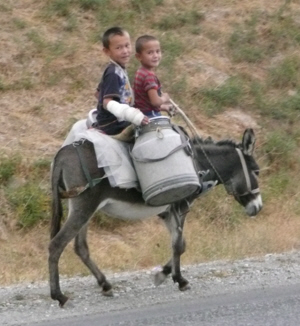
This stately elder donkey was accompanied by a foal that frolicked and gambolled up the road in a most un-donkey-like manner. (Sadly too energetically for my feeble camera skills to keep up)







